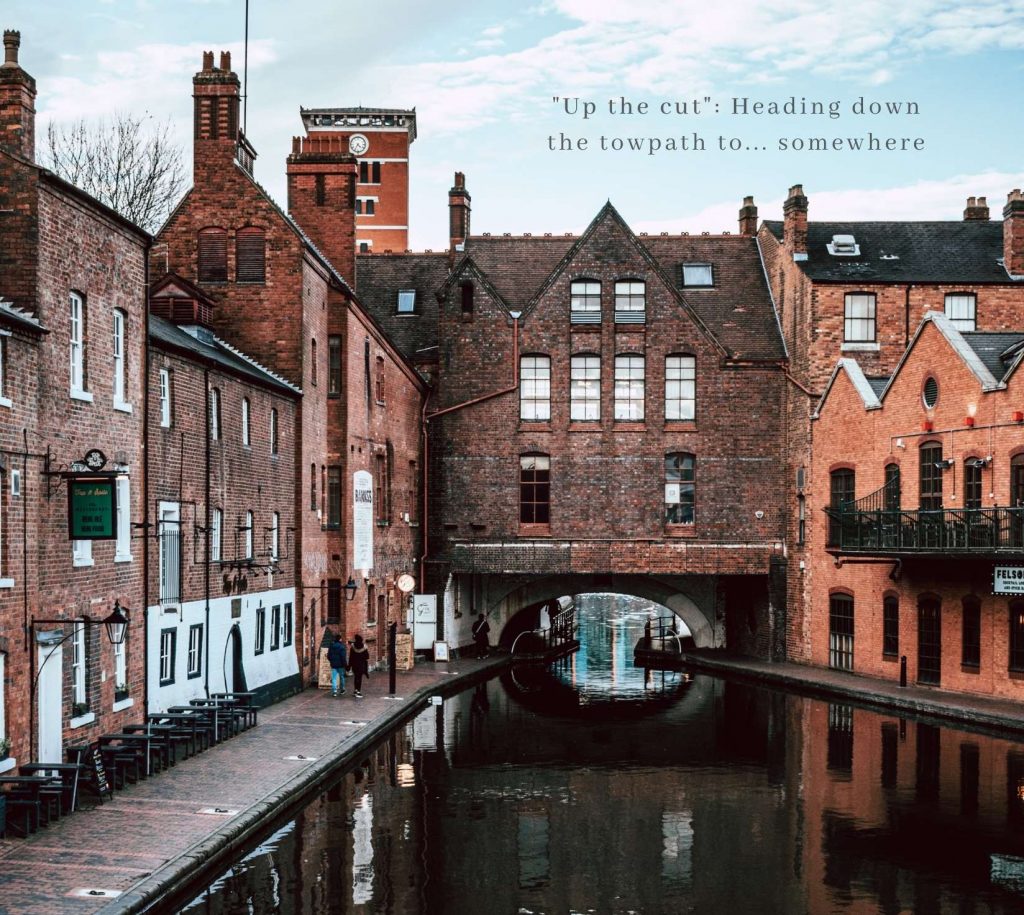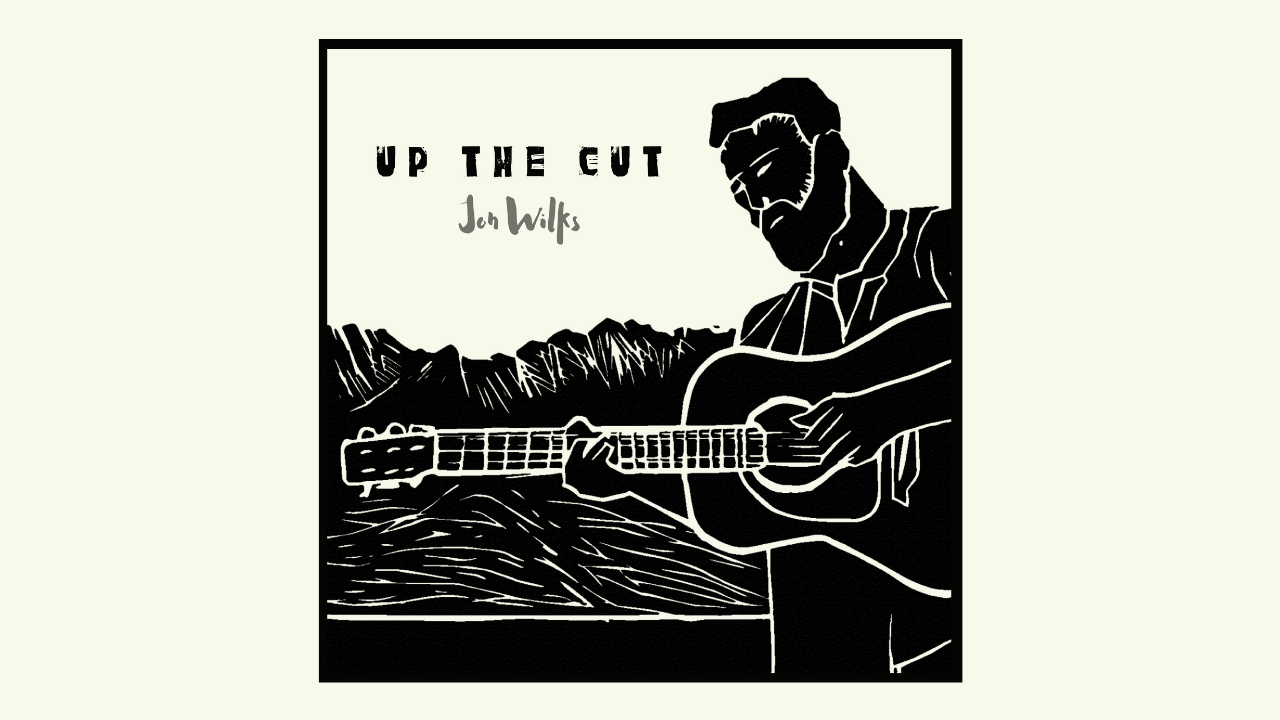NOW AVAILABLE ON CD VIA BANDCAMP. CLICK HERE TO FIND OUT MORE
“Jon Wilks’s Up the Cut explores the fascinating history of Birmingham street balladry, a thriving 19th-century industry, through simple, deeply affecting voice-and-guitar settings. The Lover’s Ghost and Stowaway are especially beautiful, delicate with love and loss.” – Jude Rogers, The Guardian review
“Up The Cut is a beautiful album. Affecting, simple guitar, exquisitely accompanied by Wilks’ authentic, honest voice. A raw, but entirely seductive, performance. One for all lovers of traditional songs delivered with minimal frills.” – Folk Radio UK review
“The guitar playing is clear, precise and tuneful, with complex lines and clever flourishes in places, adding brushes of colour… There really isn’t anything close to a dud here; all ten songs are memorable and have been treated with the utmost respect. Packaged beautifully with extensive notes, this generous and hugely satisfying album is hard to fault.” – Songlines review
“Another terrific, suitably spit and sawdust collection of traditional folk songs, many dusted down and rescued from obscurity and given a suitably robust Wilks treatment. Glorious.” – Mike Davies, Folking.com
“Great album. Got the same thrill from it when I bought my first Transatlantic and Topic LPs.” – Bev Harris, Mainly Folk Radio Show
Up The Cut, an album of traditional songs from Birmingham and the wider Midlands, was released on February 12th, 2021. You can hear it on the links below and read about it on this page.
On Bandcamp | On Spotify | On Apple Music | On Amazon Music | On Deezer
Somewhat different to my last album, Midlife, these songs were recorded with just my guitar and my vocal, without overdubs. It’s as stripped-down as I get. I hope you like it.
T-shirts and other merchandise are also available via this link. Or you can scroll right to the bottom of this page and see what’s on offer.
If this album is the result of anyone’s hard work, it’s that of Roy Palmer. Seven out of the nine songs came to me via his research, publishing and collecting. Thanks, too, must go to Pat Palmer, Roy’s widow, who sent me (via a kind introduction from Pam Bishop, another Birmingham folk researcher) a sheath of songs that Roy had worked on a number of years before his death. Pat’s kind gift prompted me to realise that there were plenty more traditional songs from Birmingham and the wider Midlands area that had yet to be recorded. From that realisation, this album was born.
I began working on Up The Cut in August, 2019, and am completing it with these sleeve notes in early December, 2020. It feels like I’ve had these songs going around in my head for a very long time indeed. While my initial intention was to treat them to the same larger-scale production I used on my previous album, Midlife, in the end I decided to offer up this collection of straightforward acoustic guitar and vocal performances, with the intent of not distracting the listener too heavily from the songs themselves. My hope is simply to put some of the lesser-known songs back into circulation so that people with a little more verve and flair can give them even more life than I can.
In getting the songs to this stage, I owe a huge amount to Tom Moore and to Andi Lee. Tom and I recorded a version of the album in October, 2020, at his wonderful studio in Yaxham, Norfolk. In the end, I was disappointed with my own performances, but it served as a very useful kind of demo. Tom is a fantastic producer, and of course a wonderful musician in his own right. The few days I spent with him were incredibly productive, and very helpful for me to be able to nail down some of the more troublesome arrangements.
Returning home, I re-recorded the songs with my own recording setup, and then sent them to Andi Lee at Kosi Studios in Slovakia. Andi is a very patient recording engineer with a great pair of ears. Over the final two months of 2020, he helped me take my rough re-recordings and turn them into something you might actually want to listen to. He became a great friend in the process, too. I shall look forward to working with him again in the future.
Aside from that, my thanks go to Emi, Kai and Hana – my long-suffering family who have had to put up with hearing endless iterations of these songs over the last 16 months. I’m sure they could sing them, word for word, better than I can. Also to Jon Nice, whose wonderful linocut I was able to use for the album cover, and to Em Kuntze for her proofreading skills. Huge thanks to Claire Patterson for her friendship and support in all that I create. And a big shout out, too, to Debbie Armour, Jackie Oates and Katherine Priddy for lending me their ears during mixing. It has been a long journey… thank goodness we got there in the end.
SOME BACKGROUND INFO ON THE SONGS
As I mentioned above, a few of these songs came from a collection of street ballads given to me by Mrs Pat Palmer, the widow of the late, great scholar, Roy Palmer. The collection is an unbound sheath of papers that includes photocopies of some fairly obscure Brummie songs, put together by Roy in 1979 for the City of Birmingham Education Department. Each song has details attached to it, which I cross-referenced against a book called Street Literature In Birmingham, edited by Trevor Jones in 1970. I got the latter book as a Christmas present and, yes folks, I’ve spent hours upon hours since then with my nose stuck in what is essentially a list of Birmingham printers’ addresses from the 1800s. My family despair of me.
Roy Palmer’s collection begins with an overview of 19th century street balladry in Birmingham. I find this stuff fascinating, so I hope you will, too.
The city has a rich history of street songs. In 1790, the poet George Davis noted that The Fox, a pub on Castle Street (a fraction of which still exists near the new Primark), was home to “hawkers and ballad singers – sworn foes to dull sobriety and care”. Indeed, so many of them haunted the streets of Brummagem that the authorities decided to act. In 1794, “beggars, ballad singers and other vagrants” were outlawed, and license was given to apprehend any caught “strolling… within the parish”.
However, this didn’t last long. Songs meant income, and the balladeers appear to have done such a roaring trade in villages outside of the parish that the authorities eventually relented. As Roy Palmer deftly illustrates: In the year 1800 there were no ballad printers in Birmingham, and in 1885 there were also no ballad printers in Birmingham. But during that 85-year span, 40 came and went. By his estimation, millions of songs were printed and sold. Writing and singing songs became a vast Brummie industry.
It was sometimes very lucrative, too. Ballad printer, Joseph Russell, left an estate of £20,000 in 1839. That’s roughly £2 million in today’s money. One of his contemporaries had approximately 4,000 individual songs on his books. With these numbers you begin to see just how enormous the Brummie back catalogue must have been. Sure, much of it was doggerel, but there are gems there if you will but look.
Most of these song publishing fortunes were built on the pennies of the poor, of course, and in order to write for the masses the songwriters had to really get inside their everyday wants, pleasures and needs. In the archives you’ll find plenty of ghost stories, songs about sporting events, political screeds, descriptions of arguments between noisy neighbours, declarations of love, and descriptions of everyday street life. In short, you get a strong sense of how little changes as the centuries roll on. Humans will be humans, after all.

TRACKLIST
THE PRETTY GIRLS OF BRUMMAGEM [ROUD V1691]
Several of the songs in the sheath given to me by Pat Palmer had melodies suggested for them. In some of these instances, Roy provided what seemed to be handwritten (but photocopied) scores. However, in many cases no melodies or suggestions were given at all. This song fell into the latter category, and so I sat down and wrote a tune myself. It wasn’t difficult. As soon as I saw the lyrics, this melody instantly sprang to mind. I suspect it’s a little more melancholy than the original, given that the lyrics have a kind of music hall quality about them.
Published in 1833 by Whitings, a Birmingham printer who appears to have had limited success in the songs world, the ‘Pretty Girls of Brummagem’ has the kind of title you might associate with bawdy singsongs. However, it’s quite the opposite, being something of a sweet, heartfelt look at how various Brummie men of the pre-Victorian era attempted to get the courage up to go a-courting. We hear from the cocksure dandy strutting down New Street with his “killing pair” of whiskers, the shopkeeper who fancies his chances but ends up on his arse, the chimney sweep who can only dream of going “where there is fun done”, and the “old gentleman of 64” for whom the excitement of love is an antidote to his ailments.
When Tom Moore heard me play this song, he began referring to it as “the Brummie ‘Penny Lane”, which I understood instantly. It’s a charming snapshot of love and life in 1830s Birmingham. Incidentally, a couple of interesting old phrases turn up in this song: “up the spout” apparently meant pawned, and “benjamin” was another word for a coat.
THE STOWAWAY [ROUD 6341]
Roy Palmer recorded the Staffordshire singer, George Dunn, singing this song on June 29th, 1971 – one of 14 sessions they did together over a period spanning five years.
I first heard ‘The Stowaway’ on George Dunn, Chainmaker, a double-disc album produced by MusTrad in 2002. Rod Stradling’s notes tell us that this song was known to be in the repertoire of a music hall singer, Alice Maydue, and had been collected a couple of times in Canada, as well as being printed by a number of broadside sellers in the North of England. George Dunn learned it from his father, but his version was incomplete. The version I sing here was taken from a fuller set of lyrics found in the Bodleian Harding collection.
That this song has been overlooked by other singers of traditional songs surprises me. It has a phenomenal melody with great, soaring top lines. Perhaps it’s the slightly mawkish sentiment in the lyrics that put them off. Either way, I found the tune difficult to ignore and it quickly became a bit of an ear-worm – one that I’ve found particularly difficult to shake. I hope you have the same issues.
EDWARD [CHILD 13, ROUD 200]
This is a well-known, many-times recorded Child Ballad. A smattering of collections across Britain show that it was reasonably well known here, but it seemed to take a real hold in the US – and I have to say, I think my arrangement has more of an American twang to it than most of the other songs on this album.
Roy Palmer collected this song from George Dunn in the winter of 1971, the old singer having learnt it in his childhood. I first read the lyrics in Palmer’s book Songs of the Midlands, but it wasn’t until I heard Dunn’s haunting rendition on the aforementioned, George Dunn, Chainmaker, that I determined to learn it myself. It has become a personal favourite among the songs on this Up The Cut album.
JOHN RILEY [ROUD 270]
Roy Palmer recorded George Dunn singing this song on July 14th, 1971. While ‘John Riley’ is a well-known title in the traditional songs cannon, this seems to me to be rather different in lyrical and melodic content to many of the other versions I’ve heard.
It was one of those that leapt out at me from the source recording, and I’ve wondered many times since about why I haven’t found any other recordings of this particular version. While I find the final verse a little trite (surely the warning should be about not trusting fathers that go out hunting young men in the dead of night?), the haunting melody seems a peculiar one to overlook. I’d love to hear a great singer tackle this song. It’s ripe for the picking.
THE JOVIAL HUNTER OF BROMSGROVE [CHILD 18, ROUD 29]
Sometimes a title just catches you, doesn’t it? Maybe it’s just me, but this one tickles me good and proper. Maybe it has to do with memories of friends from Bromsgrove when I was a teenager – good friends; a funny bunch – but the idea of there being a proud knight roaming Bromsgrove Town and plucking troubled ladies from trees… It’s all a bit Monty Python.
It’s a good song, though, and one that has survived for a lengthy time. This is possibly the oldest song I currently have in my repertoire. A Child Ballad [Child 18], it has been through countless names and changes, and is thought to date back to a poem called Sir Eglamour of Artois, probably written around 1350.
Much like the knight in the narrative, this wonderful old song has done plenty of roaming, largely up and down the M5 corridor here in the UK, before hopping over to North America. Take a look at the VWML website and you’ll see just how well-travelled the jovial hunter of Bromsgrove is.
He’s also changed his identity a number of times, too. You can look him up under the names Sir Lionel, Bold Sir Rylas, Bangum the Boar Slayer, Sir Egrabell, Sir Eglamore, Rackabello… the list goes on.
It has been recorded countless times. It’s one of those songs where you can listen to two different versions and not realise that you’re listening to something born of the same origin. Take the recording of ‘Bold Sir Rylas’ by Spiers & Boden, and stick it in a playlist alongside ‘Wild Hog in the Woods’, recorded by The Furrow Collective and see how many differences you spot. Search then for The Demon Barbers… and suddenly we’re into uptempo reggae. Very jovial.
By the time it reached the Midlands, Bold Sir Rylas had, for whatever reason, become ‘The Jovial Hunter of Bromsgrove’. The version that I’ve recorded here is my interpretation and arrangement of the song as it appears in Roy Palmer’s book, Songs of the Midlands. Roy notes that it was collected from Benjamin Brown in Upper Wick, Worcestershire, in around 1845. Not much is known about Benjamin, but Roy writes that he was an illiterate fellow who had learnt the song some 35 years previously. So we can say with reasonable confidence that Sir Rylas had been jovial in Bromsgrove since at least 1810.
THE TRAMP’S PHILOSOPHY [ROUD 10672]
This is a song I discovered while researching ‘Holly Ho’, which I released on my EP, The Trial of Bill Burn Under Martin’s Act. Both songs came from the singing of Joe Mallen and were collected from the Old Cross Guns pub in Cradley Heath in the Black Country, by Phil Drabble. Drabble printed a verse and chorus of the song in his 1952 book, The Black Country.
Oddly enough, when I found no further information during my early research, I emailed Steve Roud to see what he knew, and it turned out he had no knowledge of the Drabble collection. I believe it has since been updated in the Roud Index archive. I eventually heard a couple of source recordings of this song, one of May Bradley (released on MusTrad) and one of Bob Mills (released on Forest Tracks). My interpretation of it falls somewhere between the two.
HOW FIVE AND TWENTY SHILLINGS WERE EXPENDED IN A WEEK [ROUD V1598]
This was listed as song number 22 in Roy Palmer’s sheath of broadside songs. Unlike ‘The Pretty Girls Of Brummagem’, this song has a melody suggested alongside it: ‘The Nutting Girl’ (Frank Kidson confirmed this when he published it in Traditional Tunes in 1891). Palmer’s notes explain that the song was published by a printer called William Pratt, who was in business in Birmingham between 1845 and 1861.
Other versions can be found with the budget adding up to varying amounts. I haven’t done the calculations, and I’m slightly too young to know how the monetary values mentioned worked, so I have no idea if it all adds up. I’m sure somebody will tell me, and I fully expect to hear that it doesn’t. One thing I know for certain is that I’ll almost certainly never perform this song live. Those lyrics are a bugger to remember.
A few interesting old Brummie words appear in this song: “bonny cock of wax” was a rum way of addressing somebody, “capers” was obviously frolicking, “congresses” were matches, “swipes” were small beers, and “strings” were shoelaces.
THE LOVER’S GHOST [CHILD 248, ROUD 179]
This is one I learnt from recordings of Cecilia Costello, specifically an album called Recordings from the Sound Archives of the BBC (Leader Records, 1975). My introduction to Cecilia, one of Birmingham’s most formidable source singers, came via a conversation with the singer Emily Portman, who was visiting me to perform in a folk club I help to run. Her performance of ‘The Cruel Mother’ thoroughly gripped me, and I duly went off to order some dusty old vinyl releases from Discogs.
The melody for this song is something else. A wild, haunting lament that really challenges the singer, leaping from the lowest to the highest notes in the register. Recorded on November 30th, 1951, by Marie Slocombe and Patrick Shuldham-Shaw, the original BBC sleeve notes claim that, “the ballad was circulating in England as early as the seventeenth century, but no version as fine as Mrs Costello’s has been collected”. I’ve read theories elsewhere that suggest that the historical content of that sentence may be incorrect, but I’m willing to lay money on the latter part being entirely accurate. It’s extraordinary.
LITTLE GREY ‘OSS [ROUD 393]
Yet another song from the singing of George Dunn, although this one was recorded during a visit by Ewan MacColl and Peggy Seeger in 1971, rather than by Roy Palmer. Their notes tell us that George was only able to recall verses five and seven. The two collectors felt they knew the song under a different title (‘The Adventures of a Penny’), and when they furnished him with a full set of lyrics he pounced on them, presumably adding the complete song to his repertoire. In his final years, he’d become quite a popular singer amongst folk revivalists, and had taken the time to remember many more songs from his youth. This one must have slotted right in.
I’ve been faithful to the lyrics for the most part, rewriting only the final lines of verses six and seven as I felt sure that the rather unimaginative repetition in the George Dunn version may have had something to do with his memory in the moment of performance. Perhaps I was wrong. In which case, keep repeating “five pound three” for authenticity.
GOD REST YE MERRY GENTLEMEN [ROUD 394]
I found this broadside version of the well-known carol on the Broadside Ballads website. Printed by D. Wrighton at 86 Snow Hill, Birmingham, sometime between 1812-30, it contains lyrics I don’t recognise from my school days. Throwing down Satan wasn’t a major part of Yuletide festivities in 1980s Solihull, as far as I recall.
As soon as I realised this album was likely to be out in time for winter, I knew I had to include a recording of this song. Sure, it’s a bit cheesy to do a Christmas song, but I feel it’s something of a Midlands tradition. If Slade can do it, then I’ll have a bash, too. This one’s for Noddy. Oi, oi!
Pre-order the album, Up the Cut, from the Jon Wilks Bandcamp page. It will be released on Feb 12th.




Leave a Reply